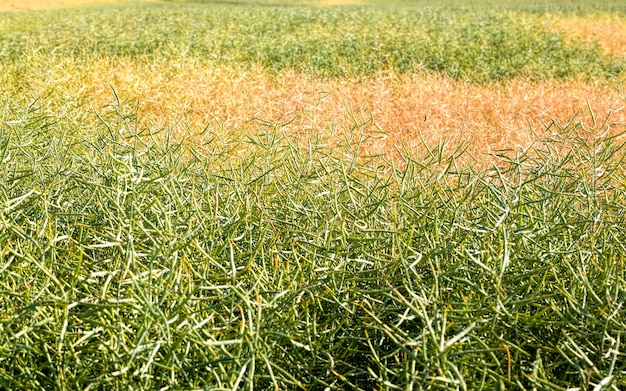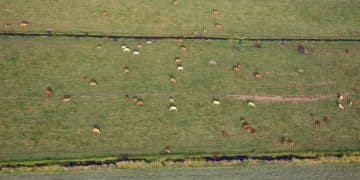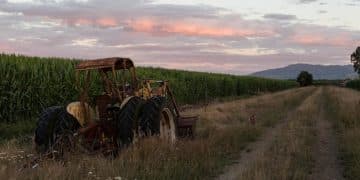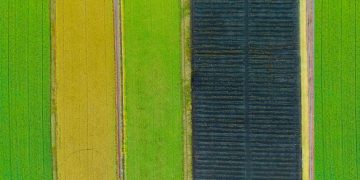Cover Cropping: Reduce Nitrogen Fertilizer Needs by 20% in 3 Years

Discover how cover cropping can significantly reduce your nitrogen fertilizer needs by up to 20% within three years, enhancing soil health and promoting sustainable agricultural practices.
Are you looking for sustainable ways to improve your farm’s productivity while reducing your reliance on synthetic fertilizers? Discover how cover cropping can reduce your nitrogen fertilizer needs by 20% within 3 years, offering a practical and environmentally friendly approach to modern agriculture.
Unlocking the Potential of Cover Cropping for Nitrogen Reduction
Cover cropping is gaining traction as a vital practice in sustainable agriculture. It involves planting specific crops primarily to benefit the soil, rather than for harvest as a commodity. One significant advantage of cover cropping is its ability to reduce the need for nitrogen fertilizers, a costly and environmentally impactful input in many farming systems.
This section explores the mechanisms through which cover crops contribute to nitrogen reduction, the types of cover crops best suited for this purpose, and practical considerations for integrating them into your farming operation.
The Science Behind Nitrogen Fixation
Certain cover crops, particularly legumes, have a symbiotic relationship with nitrogen-fixing bacteria in the soil. These bacteria convert atmospheric nitrogen into forms that plants can use, effectively enriching the soil with this essential nutrient.
- Legumes like clover, vetch, and peas are popular choices for nitrogen fixation.
- Non-legume cover crops can also contribute by scavenging residual nitrogen in the soil, preventing it from being lost through leaching or denitrification.
- A mix of legume and non-legume cover crops can provide a balanced approach to nitrogen management.
By understanding the scientific principles behind nitrogen fixation and the role of different cover crop species, farmers can make informed decisions about which cover crops to use in their specific context.
In conclusion, cover cropping offers a natural and effective way to reduce nitrogen fertilizer needs by leveraging the power of nitrogen fixation and nutrient scavenging. This practice not only benefits the environment but also contributes to long-term soil health and farm sustainability.

Selecting the Right Cover Crops for Nitrogen Management
Choosing the appropriate cover crops is crucial for maximizing nitrogen reduction benefits. The selection process depends on factors such as your climate, soil type, cropping system, and specific goals.
This section provides guidance on selecting cover crops tailored to your needs, focusing on both legume and non-legume options and their respective advantages.
Legume vs. Non-Legume Cover Crops
Legumes are renowned for their nitrogen-fixing capabilities, while non-legumes excel at scavenging existing nutrients in the soil. A strategic combination of both can optimize nitrogen management.
- Legumes: Clover, vetch, peas, beans (e.g. fava beans, soybeans) effectively fix nitrogen from the atmosphere. Choose legumes suitable for your climate and soil conditions.
- Non-Legumes: Rye, oats, radishes are excellent at scavenging residual nitrogen, preventing nutrient loss. They can also improve soil structure and suppress weeds.
- Mixtures: Combining legumes and non-legumes offers a balanced approach, providing both nitrogen fixation and nutrient scavenging benefits.
Carefully consider the characteristics of different cover crop species to select the ones that best align with your farm’s requirements and objectives.
In summary, selecting the right cover crops involves assessing your specific needs and choosing species that complement your farming system. Whether you opt for legumes, non-legumes, or a mixture, the key is to make informed decisions that maximize nitrogen management benefits.
Integrating Cover Crops into Your Farming System
Integrating cover crops effectively requires careful planning and adaptation to your existing farming system. Timing, planting methods, and termination strategies are all critical considerations.
This section provides practical guidance on how to seamlessly incorporate cover crops into your rotation, ensuring they contribute to nitrogen reduction without disrupting your primary crop production.
Best Practices for Planting and Termination
Proper planting and termination techniques are essential for realizing the full benefits of cover cropping. These practices ensure that cover crops establish quickly, fix or scavenge nitrogen efficiently, and are terminated at the appropriate time to avoid interference with subsequent crops.
Integrating cover crops into your farming system requires a strategic approach that considers your specific needs and objectives. By following these best practices, you can successfully incorporate cover crops into your rotation, reduce nitrogen fertilizer needs, and enhance the sustainability of your farm.
- Timing: Plant cover crops after harvesting your main crop to maximize their growth period.
- Terminate at the right time: The termination of cover crop should occur before planting the row crops you have planned for that land.
- Planting Method: Use appropriate seeding rates and methods to ensure uniform establishment. Consider factors such as seed size, soil moisture, and seed-to-soil contact.
- Termination: Choose termination methods that suit your cropping system and environmental conditions. Options include mowing, herbicide application, tillage, and natural winter kill.

Measuring the Impact: Assessing Nitrogen Reduction
To effectively manage nitrogen and track the benefits of cover cropping, it’s essential to monitor and assess changes in soil nitrogen levels. Regular soil testing is a valuable tool for this purpose.
This section explores practical methods for measuring the impact of cover crops on nitrogen reduction, enabling you to make informed decisions and fine-tune your strategies for optimal results.
Soil Testing Techniques and Interpretation
Soil testing provides valuable insights into the availability of nitrogen in your soil, allowing you to adjust fertilizer applications accordingly.
Regular soil testing helps farmers fine-tune their nitrogen management strategies, reduce fertilizer inputs, and enhance the overall sustainability of their operations. By accurately measuring and interpreting soil nitrogen levels, you can make informed decisions that benefit both your farm and the environment.
- Sampling: Collect soil samples from various locations within your field to obtain a representative assessment. Follow recommended sampling procedures for accurate results.
- Analysis: Send soil samples to a certified laboratory for nutrient analysis. Request tests that measure available nitrogen forms, such as nitrate and ammonium.
- Interpretation: Compare soil test results to established guidelines for your region and crop type. Consult with agricultural extension agents or soil scientists for expert advice.
Addressing Challenges and Optimizing Cover Cropping
While cover cropping offers numerous benefits, it’s not without its challenges. Factors such as establishment costs, potential yield reductions in the short term, and management complexities can pose obstacles.
This section addresses common challenges associated with cover cropping and provides strategies for optimizing your approach, ensuring you reap the full benefits of nitrogen reduction and soil health improvement.
Overcoming Common Obstacles
Addressing the obstacles, you can successfully integrate cover crops into your farming system, reduce your reliance on synthetic fertilizers, and enhance the sustainability of your operation.
- Establishment Costs: Explore cost-sharing programs and grants to offset the initial investment in cover crop seed and planting.
- Yield Reductions: Select cover crop species and management practices that minimize potential negative impacts on subsequent crop yields.
- Management Complexity: Seek guidance from agricultural extension agents or experienced cover croppers to navigate the complexities of integration and optimization.
By proactively addressing challenges and embracing innovative solutions, you can maximize the value of cover cropping in your farming system.
Success Stories: Farmers Reducing Nitrogen with Cover Crops
Real-world examples can provide valuable inspiration and insights for farmers considering cover cropping. Examining the experiences of others who have successfully reduced nitrogen fertilizer needs can offer practical guidance and demonstrate the potential of this sustainable practice.
This section shares success stories showcasing farmers who have effectively implemented cover cropping to achieve significant nitrogen reduction, highlighting their strategies, challenges, and key takeaways.
Case Studies from Across the US
The experiences of these farmers demonstrate that cover cropping is not a one-size-fits-all solution but rather a flexible and adaptable strategy that can be tailored to various farming systems and environmental conditions.
By sharing these success stories, we aim to inspire and empower other farmers to embrace cover cropping as a means of reducing nitrogen fertilizer needs, improving soil health, and enhancing the sustainability of their operations.
- Midwest Corn and Soybean Farmer: Reduced nitrogen fertilizer application by 30% through the use of a legume cover crop mix.
- Southeastern Vegetable Grower: Improved soil health and reduced fertilizer costs by incorporating cover crops into their rotation.
- Western Wheat Producer: Suppressed weeds and reduced nitrogen fertilizer inputs by using a cereal rye cover crop.
| Key Point | Brief Description |
|---|---|
| 🌱 Nitrogen Fixation | Legumes convert atmospheric nitrogen into plant-usable forms. |
| 🌾 Nutrient Scavenging | Non-legumes capture residual nitrogen, preventing loss. |
| ⏱️ Timing Matters | Plant after harvest; terminate before subsequent crops. |
| 🧪 Soil Testing | Monitor nitrogen levels to optimize fertilizer use. |
FAQ
▼
Cover cropping enhances nitrogen availability through fixation by legumes and scavenging by non-legumes. Thus reduces the need for synthetic fertilizers, improves soil health, and prevents nutrient loss.
▼
Consider your climate, soil type, cropping system, and goals. Legumes fix nitrogen, non-legumes scavenge nutrients. A mix can provide balanced benefits.
▼
Plant after harvesting your main crop, use appropriate seeding rates, and ensure good seed-to-soil contact. Terminate at the right time to avoid interfering with your row crops
▼
Regular soil testing is essential. Collect samples from various field locations and send them to a certified lab for nutrient analysis, including forms of nitrogen in the soil.
▼
Challenges include establishment costs, potential yield reductions, and management complexities. Cost-sharing programs and expert guidance can help mitigate these issues, reducing yield losses.
Conclusion
Embracing cover cropping is a strategic move towards sustainable agriculture, offering a practical way to reduce nitrogen fertilizer needs and enhance soil health. By understanding the principles, selecting the right cover crops, and implementing best practices, farmers can achieve significant nitrogen reduction and create a more resilient and environmentally friendly farming system. The success stories from across the US demonstrate the real-world potential of cover cropping, offering valuable insights and inspiration for those ready to adopt this transformative practice.





